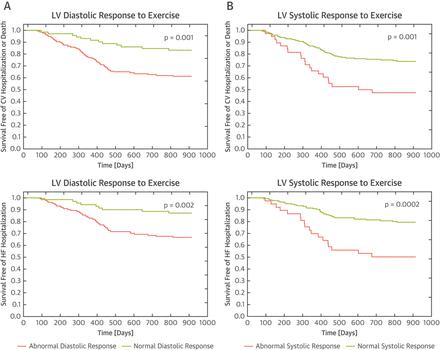当前位置:
X-MOL 学术
›
JACC Cardiovasc. Imaging
›
论文详情
Our official English website, www.x-mol.net, welcomes your
feedback! (Note: you will need to create a separate account there.)
Association of Abnormal Left Ventricular Functional Reserve With Outcome in Heart Failure With Preserved Ejection Fraction.
JACC: Cardiovascular Imaging ( IF 12.8 ) Pub Date : 2017-11-15 , DOI: 10.1016/j.jcmg.2017.07.028 Wojciech Kosmala 1 , Monika Przewlocka-Kosmala 1 , Aleksandra Rojek 2 , Andrzej Mysiak 2 , Andrzej Dabrowski 3 , Thomas H Marwick 4
JACC: Cardiovascular Imaging ( IF 12.8 ) Pub Date : 2017-11-15 , DOI: 10.1016/j.jcmg.2017.07.028 Wojciech Kosmala 1 , Monika Przewlocka-Kosmala 1 , Aleksandra Rojek 2 , Andrzej Mysiak 2 , Andrzej Dabrowski 3 , Thomas H Marwick 4
Affiliation

|
OBJECTIVES
This study sought to determine the prognostic value of abnormal diastolic and systolic responses to exercise (on the basis of exertional E/e' and global longitudinal strain rate [GSR]) in a well-characterized population of patients with heart failure with preserved ejection fraction (HFpEF).
BACKGROUND
Impaired cardiovascular functional reserve is believed to contribute to adverse outcomes in HFpEF. However, the exact characteristics of pathophysiological profiles associated with increased clinical risk are still poorly defined.
METHODS
A complete echocardiogram (including assessment of myocardial deformation) was performed at rest in 205 patients (64 ± 8 years of age) with symptomatic HFpEF. Echocardiography following maximal exercise was undertaken to assess abnormal diastolic reserve (AbnDR) (exertional E/e' >14) and exercise GSR. Patients were followed over 26 ± 5 months for death and cardiovascular or heart failure (HF) hospitalization.
RESULTS
Cardiovascular hospitalization or death occurred in 64 patients (31%), including 51 (25%) with HF hospitalization. The composite endpoint was associated with AbnDR (hazard ratio: 2.69; 95% confidence interval: 1.44 to 5.04; p = 0.002) and reduced exercise GSR (hazard ratio: 0.14; 95% confidence interval: 0.04 to 0.49; p = 0.002). Both exercise parameters showed prognostic value, independent from and incremental to clinical data and B-type natriuretic peptide. The ability of E/e' and GSR measurements to predict outcomes on exertion exceeded their prognostic value at rest, and the presence of reduced exertional GSR in patients with AbnDR was associated with worse prognosis (p = 0.03 for the composite endpoint and p = 0.01 for HF hospitalization).
CONCLUSIONS
Both left ventricular systolic and diastolic reserves contribute to risk prediction in HFpEF. The inclusion of the exertional assessment of left ventricular function to diagnostic algorithms may improve the prognostication process in this disease condition.
中文翻译:

左心室功能储备异常与心力衰竭结果与保留射血分数的关系。
目的本研究旨在确定特征明确的心力衰竭伴射血保留的人群中运动异常的舒张和收缩反应对运动的预后价值(基于运动E / e'和总体纵向应变率[GSR])分数(HFpEF)。背景技术据信心血管功能储备受损会导致HFpEF的不良预后。然而,与临床风险增加相关的病理生理特征的确切特征仍不清楚。方法205例有症状的HFpEF患者在休息时进行了完整的超声心动图检查(包括评估心肌变形)。进行最大程度运动后进行超声心动图检查以评估舒张期储备异常(AbnDR)(运动E / e'> 14)锻炼GSR。对患者进行了超过26±5个月的死亡和心血管或心力衰竭(HF)住院治疗。结果心血管住院或死亡发生在64例患者中(31%),其中51例(25%)发生了HF住院。综合终点与AbnDR(危险比:2.69; 95%置信区间:1.44至5.04; p = 0.002)和降低运动GSR(危险比:0.14; 95%置信区间:0.04至0.49; p = 0.002)相关。两种运动参数均显示出预后价值,与临床数据和B型利钠肽无关,并与之相关。E / e'和GSR测量值预测劳累结局的能力超过了其静息时的预后价值,而且AbnDR患者劳累性GSR降低与预后差有关(p = 0。复合终点为03,HF住院p = 0.01)。结论左心室收缩和舒张储备均有助于HFpEF的风险预测。将左心室功能的运动评估纳入诊断算法可以改善这种疾病情况下的预后过程。
更新日期:2018-12-04
中文翻译:

左心室功能储备异常与心力衰竭结果与保留射血分数的关系。
目的本研究旨在确定特征明确的心力衰竭伴射血保留的人群中运动异常的舒张和收缩反应对运动的预后价值(基于运动E / e'和总体纵向应变率[GSR])分数(HFpEF)。背景技术据信心血管功能储备受损会导致HFpEF的不良预后。然而,与临床风险增加相关的病理生理特征的确切特征仍不清楚。方法205例有症状的HFpEF患者在休息时进行了完整的超声心动图检查(包括评估心肌变形)。进行最大程度运动后进行超声心动图检查以评估舒张期储备异常(AbnDR)(运动E / e'> 14)锻炼GSR。对患者进行了超过26±5个月的死亡和心血管或心力衰竭(HF)住院治疗。结果心血管住院或死亡发生在64例患者中(31%),其中51例(25%)发生了HF住院。综合终点与AbnDR(危险比:2.69; 95%置信区间:1.44至5.04; p = 0.002)和降低运动GSR(危险比:0.14; 95%置信区间:0.04至0.49; p = 0.002)相关。两种运动参数均显示出预后价值,与临床数据和B型利钠肽无关,并与之相关。E / e'和GSR测量值预测劳累结局的能力超过了其静息时的预后价值,而且AbnDR患者劳累性GSR降低与预后差有关(p = 0。复合终点为03,HF住院p = 0.01)。结论左心室收缩和舒张储备均有助于HFpEF的风险预测。将左心室功能的运动评估纳入诊断算法可以改善这种疾病情况下的预后过程。











































 京公网安备 11010802027423号
京公网安备 11010802027423号